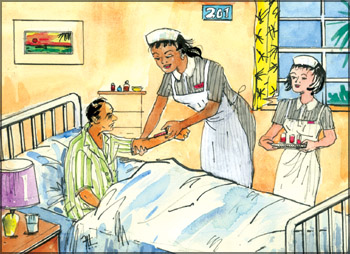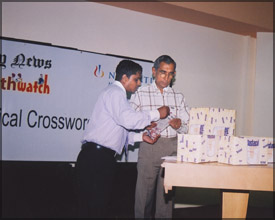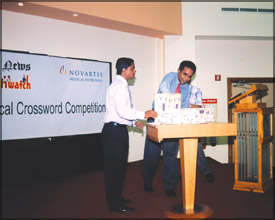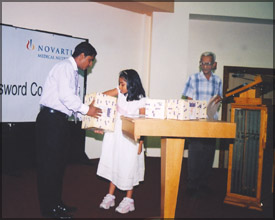|

Compiled & Coordinated by Edward Arambewala
Educating the public on Blood Count
The full blood count (FBC)
Kelum Pelpola (Final year Medico - Colombo Medical Faculty)
The full blood count (FBC), is one of the most commonly performed
blood tests, as it can tell us so much about the status of our health.
It is important for diagnosing conditions in which the number of blood
cells is abnormally high or abnormally low. In this article, the readers
can get a general idea about the components of the full blood count and
their significance in clinical practice.
A full blood count measures:
. the amount of haemoglobin in the blood;
. the number of red blood cells (red cell count);
. the percentage of blood cells as a proportion of the total blood
volume (haematocrit or packed cell volume);
. the volume of red blood cells (mean cell volume-MCV)
. the average amount of haemoglobin in the red blood cells (known as
mean cell haemoglobin - MCH);

. the number of white blood cells (white cell count);
. the percentages of the different types of white blood cells (leucocyte
differential count); and
. the number of platelets (platelet count)
Haemoglobin (Hb) is an iron-containing compound found in the red
blood cells, which transports oxygen around the body. Measuring the
concentration of haemoglobin in the blood can help diagnose anaemia,
(when the haemoglobin concentrations are lower than normal) a condition
caused by a deficiency of haemoglobin. Anaemia can arise due to:
. too few red blood cells;
. inadequate iron intake;
. inadequate vitamin B12 intake;
. blood loss;
. blood cell destruction; or
. a defect in the haemoglobin molecule itself.
This measurement may also detect abnormally high concentrations of
haemoglobin which may happen in conditions like an abnormal increase in
red cell production by the bone marrow (polycythemia vera).
The normal haemoglobin level for adult males is 130-180 g/L (13-18
mg/dl), and 115-165 g/L (11.5-16.5 mg/dl) for adult females.
Red cell count (RCC) is an estimation of the number of red blood
cells per litre of blood. Abnormally low numbers of red blood cells may
indicate anaemia as a result of blood loss, bone marrow failure,
malnutrition such as iron deficiency etc.
Abnormally high numbers of red blood cells may indicate congenital
heart disease, some lung diseases, dehydration or kidney disease.
The normal red cell count for adult males is 4.5-6.5 x 10 12/L, and
3.8-5.8 x 10 12/L for adult females.
Packed cell volume (PCV) or haematocrit (Hct) is a measure of the
percentage of red blood cells to the total blood volume.
A low haematocrit may indicate anaemia, blood loss, bone marrow
failure, leukaemia, multiple myeloma, nutritional deficiency,
over-hydration or rheumatoid arthritis. A high haematocrit may indicate
dehydration (for example, due to burns or diarrhoea), eclampsia (a
serious condition that can occur during pregnancy) or polycythaemia
vera.
The normal haematocrit range for adult males is 40-54 per cent, and
37-47 per cent for adult females.
Mean cell/corpuscular volume (MCV) is an estimate of the volume of
red blood cells. It is useful for determining the type of anaemia a
person might have. A low MCV may be seen in iron deficiency, chronic
disease or even pregnancy. A high MCV may indicate anaemia due to
nutritional deficiencies, bone marrow abnormalities, liver disease,
alcoholism etc. The normal MCV range for adults is 80-100 fL.
Mean cell/corpuscular haemoglobin (MCH) and mean cell/corpuscular
haemoglobin concentration (MCHC), are further guides to the
investigation of anaemia.
The MCH is the haemoglobin content of the average red cell. The MCHC
is the average haemoglobin concentration in a given volume of packed red
cells.
The MCH may be low in types of anaemia where the red blood cells are
abnormally small, or high in other types of anaemia where the red blood
cells are enlarged (for example, as a result of folic acid or vitamin
B12 deficiency).
The MCHC is low in iron deficiency, blood loss, pregnancy and
anaemias caused by chronic disease. The normal MCH range for adults is
27-32 pg, and the normal MCHC range is 300-350 g/L.
White cell (leucocyte) count estimates the total number of white
blood cells per litre of blood.
An abnormal high or low white cell count can indicate many possible
medical conditions and a leucocyte differential count, which provides
numbers of the different types of white cells, is usually needed to help
make any diagnosis.
Abnormally low numbers of white blood cells may indicate spleen
disorders, bone marrow disorders, or exposure to radiation or toxic
substances. Abnormally high levels of white blood cells may indicate
infection, tissue damage, leukaemia, or inflammatory diseases.
The normal white cell count for adults is 4.0-11.0 x 10 9/L
Leucocyte (white cell) differential count provides an estimate of the
numbers of the 5 main types of white blood cells. These are:
neutrophils; monocytes; lymphocytes; eosinophils; and basophils.
Each of the five types has a specific role in the body.
Neutrophils and monocytes protect the body against bacteria and eat
up small particles of foreign matter.
Lymphocytes are involved in the immune process, producing antibodies
against foreign organisms, protecting against viruses and fighting
cancer.Eosinophils kill parasites and are involved in allergic
responses. High numbers of eosinophils may be associated with worm
infections or exposure to substances that cause allergic reactions.
Basophils also take part in allergic responses.
Platelet count is an estimation of the number of platelets per litre
of blood. Abnormally low numbers of platelets is known as
thrombocytopenia, while an abnormally high level of platelets is known
as thrombocytosis.
In the Sri Lankan context, platelets are important in diagnosing and
management of dengue fever.
They may also be used to help diagnose problems associated with
abnormal bleeding or bruising.
The normal platelet count for adults is 150-400 x 10 9/L.
Most of the time, the normal ranges of the values for the different
components are given in the report, and the values were given for
completeness sake. It should be noted that the values given above may
slightly change in different contexts.
This article is meant to give a basic idea only, regarding the full
blood count, which is a frequent investigation is done in clinical
practice. It should be emphasized though, that interpreting a report is
best done by a doctor, because it should be done along with the
patient's symptoms and results of other investigations.
The idea of this article was to familiarize the readers with the
commonly used jargon in describing the full blood count.
Sri Lanka's First CD on clinical neurology
Dr. Dennis J. Aloysius (Visiting Lecturer PGIM)
Dr. J. B. Peiris has been a much sought teacher of medical
undergraduates and postgraduates for over 35 years. His lectures have
always been well illustrated. With the introduction of Power Point he
has improved on the excellence in his presentations.
From about the year 2000 all his presentations have been on Power
Point making it easier to save for future use, for computer based
learning by a wide sector. Computer based distant learning without being
actually present at a lecture or presentation is now widely used by
doctors and medical students. It is not uncommon for undergraduate and
postgraduate students to request a presentation to be copied on to a
thumb drive or CD for their personal use.
Dr. Peiris hence decided to format and save his Power Point lectures
to a CD. As the PP lectures with visuals occupy much space, he has
formatted the PP slides as a word document and added explanatory
comments side by side, so that the lecture could be easily followed - in
many ways as good as or even better than the original presentation.
Dr. J.E. Peiris has previously written two popular books for medical
undergraduates and postgraduates titled 'The Short and Long of Neurology
Clinicals for the MD MRCP' and "MRCP2 - Neurology for PACES'. In this
day and age he thought that it would be appropriate and keeping with the
times to compile the lectures he had delivered into a CD, which can be
utilised wherever a computer and time are available.
This is probably the first time that medical teacher in Sri Lanka has
made compilation of a series of his lectures available as teaching CD, I
am reliably informed that he has done it all by himself on his laptop.
This CD contains 15 lectures on topics such as Alzhelmer's Disease,
Abnormal Movements, Dizziness and vertigo, Fits in adults, Headache,
Hemiplegia, Strokes, Space occupying lesions, Coma, Neurological
diagnosis, and blindness .
- truly a veritable feast of clinical neurology.
HealthWatch Medical Crossword Draw No. 26
|

Chief Guest at the event B.U head of Nestles’ HealthCare Nutrition Mr.
Madhar Joshi from India picking the 1st prize winner. |
Picture focus of Novartis (now Nestle) Medical Nutrition sponsored
HealthWatch Medical Crossword Draw No. 26 held at the Colombo Apollo
Hospital Auditorium last month where the Chief Guest was the B.U head of
Nestle Health Care Nutrition in India Madhar Joshi and the guest of
honour Colombo Apollo Hospital Chairman Ajith Jayaratne.
From the HealthWatch Medical Advisory Panel Dr. Dennis J. Aloysius
and Dr. Viraj Peramuna, Nestle HealthCare Nutrition Country Manager for
Sri Lanka and Maldives Madu Siriwardena. Apollo's Deputy General Manager
Marketing Aruna Jayakody, Novelties Sales Promotion Officer Vishwa
Perera and the HealthWatch Medical Crossword No. 25 prize winners.
|

Ajith Jayaratne Chairman Apollo Hospital Colombo picking the
second prize winner. |

Colombo Apollo Hospital Deputy General Manager Marketing
Aruna Jayakody picking a winner. |
|

Dr. Dennis J. Aloysius Family Physician visiting Lecturer
PGIM and Member HealthWatch Medical Advisory Panel picking a
winner. |

Little Hiruni Fernando who had come with her journalist
mother to watch the programme picking a consolation prize
winner. |
|

